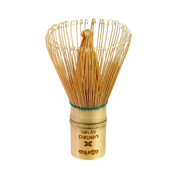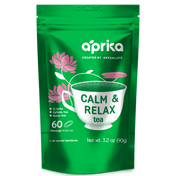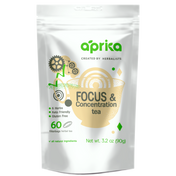Matcha Glossary
Matcha has become a household name, long-time fans are looking to explore more, while newcomers are curious about how to bring this bright green tea powder into their routines. As you search for your perfect matcha, you'll likely come across a variety of unfamiliar terms. To make your matcha shopping easier, we've put together a glossary of common Japanese tea terminologies and phrases so you can navigate your options with confidence.
-

Astringency
Astringency is the dry, slightly rough feeling in your mouth after drinking matcha.In matcha it comes from natural compounds in the tea leaves called catechins.A small amount can make matcha taste fresh, but too much can make it taste bitter or harsh. Higher-quality matcha usually has less astringency.
-

Bancha
Bancha is a type of Japanese green tea made from more mature tea leaves harvested later in the season, usually after the first or second flush. Because the leaves are older and larger, the tea has a milder, less sweet flavor with a slightly earthy or woody taste. Bancha is lower in caffeine than many other green teas and is often enjoyed as an everyday tea in Japan, both hot and cold.
-

Cafe Grade Matcha Powder
Café-grade matcha is made from a blend of first- and second-harvest leaves, creating a versatile flavor that's both bright and refreshing. Stone-ground and sealed for freshness, it offers a smooth, earthy taste that works beautifully in lattes, teas, café-style drinks, and matcha-flavoured baked goods. Naturally gluten and sugar-free, it's a go-to choice for baristas and chefs to incorporate matcha flavors into a wide range of recipes.
-

Camellia Sinensis
Camellia sinensis is the plant that produces all true tea, green, black, oolong, white, and matcha green tea, too. Every traditional tea comes from this single species; the differences come from how the leaves are grown, harvested, and processed.
-

Catechins
Catechins are natural antioxidants found in tea leaves, especially in green tea and matcha. They help protect the body from damage caused by free radicals and are linked to various health benefits. In matcha, catechins also contribute to its slightly bitter, astringent taste.
-

Ceremonial Grade Matcha Powder
Ceremonial grade matcha is the highest quality matcha, made from the youngest, most tender green tea leaves from the first harvest of the season. These leaves are shade-grown to increase sweetness and umami flavor profile, then carefully stone-ground into an ultra-fine, vibrant green powder. The flavor is smooth, naturally sweet, and rich without bitterness, making it ideal for drinking on its own, just whisked with hot water. It's the matcha used in traditional Japanese tea ceremonies, where the taste, aroma, and appearance are all part of the experience.
-

Chasen
A chasen is a bamboo matcha whisk used to prepare matcha. It has thin tines or prongs that help break up clumps of matcha powder and mix it evenly with water, creating a smooth, frothy tea. Chasen comes in different shapes and sizes, which can affect the texture of the foam. They're an essential tool in Japanese tea preparation, designed specifically for whisking matcha in a tea bowl (chawan).
-

Chashaku
A matcha scoop, called a chashaku in Japanese, is a small, curved utensil traditionally made from bamboo. It's used to measure matcha powder; one scoop is typically about 1 gram. The curved shape makes it easy to lift the fine powder from its container without spilling. While you can use a regular spoon, a chashaku is the traditional tool in Japanese tea preparation and helps measure the right amount for a smooth, consistent serving.
-

Chawan
A chawan is a wide, open matcha bowl used to prepare and drink matcha. Its shape makes it easy to whisk the tea with a bamboo whisk (chasen) and create a smooth, frothy drink. Chawan are available in a wide range of materials, including ceramic, porcelain, and glass, and come in many sizes, shapes, and designs. In Japanese tea culture, they're often chosen to match the season or occasion, but their primary purpose is to make preparing and enjoying matcha simple and comfortable.
-

Culinary Grade Matcha Powder
Culinary-grade matcha is made for mixing into matcha lattes, smoothies, cakes, matcha cookies, or any kind of culinary creation or baked goods. It comes from slightly older tea leaves, usually harvested later in the season, which gives it a bolder, more astringent flavor that doesn't get lost when blended with other ingredients. The color might not be as vibrant as ceremonial matcha, and it's not meant to be whisked up and enjoyed on its own. But when you want that earthy matcha taste to stand out in your cooking or drinks, this is the matcha grade to go for. It's punchy, versatile, and right at home in the kitchen.
-

Earthy
Earthy describes a flavor in matcha that reminds you of soil, plants, or fresh greens. It's a natural taste, also described as vegetal taste, that comes from the tea leaves and how they're grown. In matcha, earthy notes can make the flavor feel deeper and richer, especially in lower grades or later harvests.
-

First Flush or First Harvest
First flush, or first harvest, refers to the very first picking of tea leaves in the spring, just as new shoots begin to emerge after winter. These early leaves grow slowly in the cooler weather, which means they're packed with nutrients, sweetness, and depth of flavor. In Japan, this harvest is called Ichibancha, or "first tea," and it's the most prized of the year.
When it comes to matcha, first flush leaves are what you want if you're looking for smooth, vibrant, umami-rich tea. These are the leaves that go into the best ceremonial-grade matcha powder, the kind that's naturally sweet and rich without needing anything added.
-

Froth/Foam
Froth, or foam, is the bubbly layer that forms on top of matcha when it's whisked with a bamboo whisk (chasen). It's created by incorporating air into the tea while mixing, which helps blend the powder and water evenly. In usucha (thin tea), a smooth, even layer of froth is a sign of well-prepared matcha.
-

Furui
A matcha sifter is a small tool with a fine mesh used to sift matcha powder before preparing tea. It helps break up clumps and makes the powder finer and lighter, so it mixes more smoothly with water. Using a sifter results in a smoother, frothier cup without lumps, improving both the texture and taste of your matcha.
-

Genmaicha
Genmaicha is a Japanese green tea mixed with roasted brown rice. The tea is usually made with sencha or bancha leaves, and the roasted rice adds a warm, nutty aroma and flavor that balances the fresh, grassy notes of the tea. Sometimes the rice pops during roasting, giving the blend a popcorn-like appearance. Genmaicha is mild, low in caffeine, and easy to drink, making it a popular everyday tea in Japan.
-

Hojicha
Hojicha is a Japanese green tea that's roasted instead of steamed like most other green teas. The leaves, often from later harvests, are gently roasted over high heat, which turns them a warm reddish-brown and gives them a toasty, nutty aroma. The roasting balances out the grassy notes and lowers the caffeine content, making hojicha smooth, comforting, and easy to enjoy any time of day. It can be brewed as a light, fragrant tea or ground into a powder for lattes and desserts. The flavor profile is cozy and earthy, with hints of caramel or cocoa, and without the bitterness you might find in other green teas.
-

Koicha
Koicha means "thick tea" in Japanese and is a richer, more concentrated way of preparing matcha. It uses more matcha powder and less water, creating a thick, smooth paste rather than a frothy drink. Koicha is traditionally served during formal Japanese tea ceremonies and has a deep, mellow flavor with little to no bitterness. It's slower to whisk and sip, meant to be enjoyed slowly.
-

Kusenaoshi
A matcha whisk holder, or chasen kusenaoshi, is a small stand designed to hold and shape a bamboo whisk (chasen) when it's not in use. After cleaning, placing the whisk on the holder helps maintain its curved tines and prevents it from drying out or getting damaged. It keeps the whisk in good condition, so it lasts longer and performs better every time you prepare matcha.
-

Matcha
Matcha is a finely ground powdered green tea made from specially grown green tea leaves. Unlike regular green tea, where the leaves are steeped and discarded, matcha is whisked directly into water, so you're drinking the whole leaf. To make matcha green tea, tea plants are shade-grown for about three weeks before harvest. This process increases chlorophyll content and creates a sweeter, more umami-rich flavor. After harvesting, the leaves are steamed, dried, and deveined to become tencha, which is then stone-ground into the fine powder we know as matcha powder.
-

Natsume
A matcha container, called a natsume in Japanese, is a small, airtight box or tin used to store matcha powder. Its main job is to keep the matcha fresh by protecting it from air, light, moisture, and heat, factors that can quickly degrade the powder's flavor and color. Natsume containers come in various materials like metal, ceramic, or lacquered wood, and often have tight-fitting lids to preserve the vibrant color and taste of matcha.
-

Second Harvest
Second harvest, called Nibancha in Japan, is picked in early summer, just after the first flush. The tea leaves grow a little faster in the warmer weather, which gives them a bolder, stronger character compared to the soft sweetness of the spring harvest. It's not as sweet or creamy as the first harvest, but that makes it no less good. Second harvest leaves are often used for everyday teas or culinary or cafe-grade matcha, great for lattes, baking, or just a solid, no-fuss cup.
-

Sencha
Sencha is Japan's most common and widely enjoyed green tea. Unlike matcha, which is a powder whisked into water, sencha is made by steeping whole tea leaves in hot water. The leaves used for sencha are grown in full sun, then harvested, steamed to stop oxidation, rolled into thin needle-like shapes, and dried. The steaming step is what gives Japanese green teas their signature freshness and vivid green color. Flavor profile-wise, sencha is bright and grassy with a bit of natural sharpness.
-

Shade-Grown Matcha
Shade-grown means the tea plants are covered with special screens for a few weeks before harvest. Traditionally, these screens were woven straw mats, but today Japanese matcha producers often use durable black synthetic mesh made from materials like polyethylene. This partial blocking of sunlight or matcha shading makes the leaves produce more chlorophyll and amino acids like L-theanine, resulting in a deeper green color, smoother flavor, and more umami. It's one of the key steps that sets high-quality matcha apart from regular green tea.
-

Stone-Ground
Stone-ground means the tencha leaves are milled into matcha powder using large granite wheels. This traditional method grinds the leaves slowly and evenly, preventing heat buildup that could damage the flavor, color, or nutrients. It also creates an ultra-fine powder that mixes smoothly with water, which is essential for high-quality matcha.
-

Tencha
Tencha is the leaf that becomes matcha, but only after a few crucial steps. After the tea plants are shade-grown for a few weeks to deepen their color and develop sweetness, the leaves are harvested, steamed, and dried flat. Unlike other green teas, they're not rolled or shaped. The stems and veins are taken out, leaving behind soft, papery leaf flakes known as Tencha. It's not something you'd brew in a teapot. On its own, tencha is mild and a bit delicate.
-

Umami
The umami taste is one of the five basic tastes, besides sweet, sour, salty, and bitter. Umami is a savory taste that makes matcha feel rich and full. It comes from natural amino acids in the tea leaves, especially when they're shade-grown. This gives matcha a smooth, slightly sweet flavor that balances any bitterness. Umami is what makes high-quality matcha taste more balanced and enjoyable.
-

Usucha
Usucha means "thin tea" in Japanese and refers to a lighter, more common way of preparing matcha. It uses less matcha powder and more water, resulting in a milder, smoother tea with a delicate flavor and a light layer of froth on top. Usucha is often served in casual settings and for daily matcha drinking because it's quick to prepare and easy to enjoy.


































